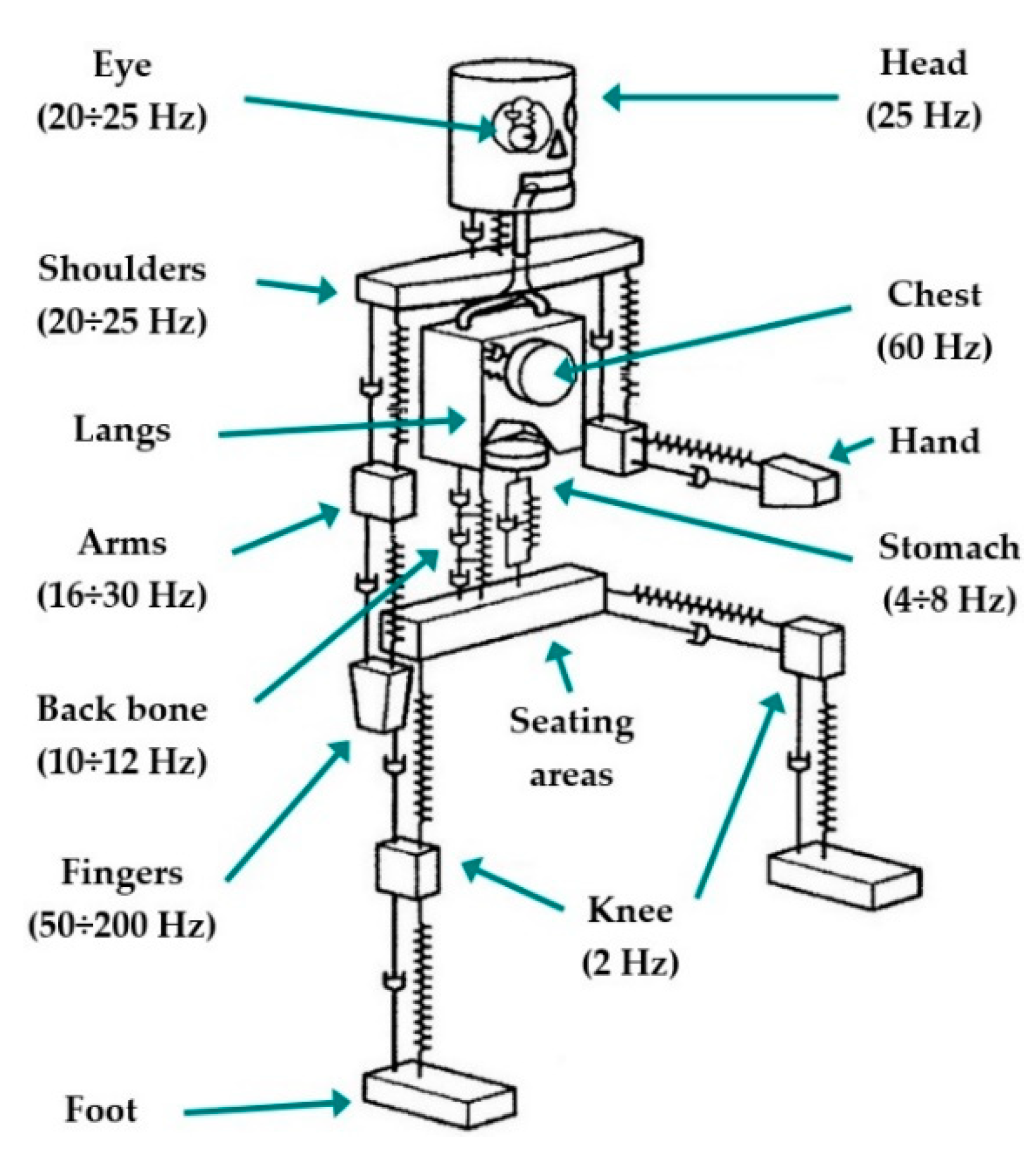Evaluation of Ride Comfort in a Railway Passenger Car Depending on a Change of Suspension Parameters
Abstract
:1. Introduction
2. Motivation and the Research Goal
3. Ride Comfort for Passengers
3.1. Evaluation of Ride Comfort for Passengers
- Average comfort: average lasting feeling evaluated by means of the indices NMV (Mean Comfort Standard Method), NVA and NVD (Mean Comfort Complete Method);
- Continuous comfort: sensations evaluated during a certain time period by means of the indices CCx, CCy and CCz (Continuous Comfort);
- Comfort during rail vehicle running in a curve: discomfort experienced during entering a curve or experienced during running in opposite curves by means of the index PCT (Comfort on Curve Transitions);
- Comfort during discrete events: discomfort experienced based on transient vibrations in a straight track and in curves for the index PDE (Comfort on Discrete Events).
- An origin: in the middle of bogies pivots, the x axis for a longitudinal direction, the y axis for a lateral direction and the z axis for a vertical direction;
- Angle φ: the definition of rotary motion around the x axis.
Calculation of the Index NMV
3.2. The Method of Evaluation of Output Signals from Simulation Computations
4. Analysis of Ride Comfort of a Railway Passenger Car by Means of the Standard Method
4.1. A Description of a Multibody Wagon Model
- A front bogie;
- A rear bogie;
- A wagon body.
- kP—stiffness of the primary spring;
- kS—stiffness of the secondary spring;
- bPV—damping coefficient of the primary vertical damper;
- bPY—damping coefficient of the primary yaw damper;
- bPL—damping coefficient of the primary lateral damper;
- bSV—damping coefficient of the secondary vertical damper.
4.2. A Description of a Track Model
4.3. Simulation Analysis and Results
5. Discussion
6. Conclusions
- The commercial simulation software Simpack was used;
- A virtual model of a railway passenger car was created;
- Passenger ride comfort was evaluated for the chosen parameters of the vehicle;
- The ride comfort index NMV on the body floor was calculated and graphs illustrating the NMV indices distributed on the body floor were depicted;
- It was concluded that the stiffness of the springs and damping coefficients of dampers of the secondary suspension system affected ride comfort more significantly than the stiffness–damping parameters of the primary suspension system.
Author Contributions
Funding
Institutional Review Board Statement
Informed Consent Statement
Data Availability Statement
Conflicts of Interest
References
- Maňurová, M.; Suchánek, A. The Analysis of a Rail Vehicle with a Tilting Bogie. Manuf. Technol. 2016, 16, 917–923. [Google Scholar] [CrossRef]
- Šťastniak, P.; Smetanka, L.; Drozdziel, P. Computer aided simulation analysis for wear investigation of railway wheel running surface. Diagnostyka 2019, 20, 63–68. [Google Scholar]
- Yu, Y.W.; Zhao, L.L.; Zhou, C.C. A new vertical dynamic model for railway vehicle with passenger-train-track coupling vibration. Proc. Inst. Mech. Eng. Part K-J. Multi-Body Dyn. 2020, 234, 134–146. [Google Scholar] [CrossRef]
- Wu, Y.; Zeng, J.; Qu, S.; Shi, H.L.; Wang, Q.S.; Wei, L. Low-Frequency Carbody Sway Modelling Based on Low Wheel-Rail Contact Conicity Analysis. Shock Vib. 2020, 2020, 71049. [Google Scholar] [CrossRef]
- Rodríguez, A.; Sañudo, R.; Miranda, M.; Gómez, A.; Benavente, J. Smartphones and tablets applications in railways, ride comfort and track quality. Transition zones analysis. Measurement 2021, 182, 109644. [Google Scholar] [CrossRef]
- Uhl, T.; Chudzikiewicz, A. Noise, vibration and durability problems in rail vehicle design. In Proceedings of the 1st International ISMA Workshop on Noise and Vibration in Agricultural and Biological Engineering, Leuven, Belgium, 13–14 September 2000; Sas, P., Moens, D., Eds.; Department Agro Enen & Econ, Catholic University Leuven: Leuven, Belgium, 2000. [Google Scholar]
- Koziak, S.; Chudzikiewicz, A.; Opala, M.; Melnik, R. Virtual software testing and certification of railway vehicle from the point of view of their dynamics. In Proceedings of the 13th International Scientific Conference on Sustainable, Modern and Safe Transport (TRANSCOM 2019), Novy Smokovec, Slovakia, 29–31 May 2019; Bujnak, J., Guagliano, M., Eds.; Elsevier: Amsterdam, The Netherlands, 2019. [Google Scholar]
- Lovska, A.; Fomin, O. A new fastener to ensure the reliability of a passenger car body on a train ferry. Acta Polytech. 2020, 60, 478–485. [Google Scholar] [CrossRef]
- Lovska, A.; Fomin, O.; Horban, A.; Radkevych, V.; Skok, P.; Skliarenko, I. Investigation of the dynamic loading of a body of passenger cars during transportation by rail ferry. EUREKA Phys. Eng. 2019, 4, 91–100. [Google Scholar] [CrossRef] [Green Version]
- Lack, T.; Gerlici, J.; Hlavňa, V. The vehicle comfort. Case study. Eksploat. Niezawodn. Maint. Reliab. 2006, 32, 89–91. [Google Scholar]
- Loulová, M.; Suchánek, A.; Harušinec, J. Evaluation of the Parameters Affecting Passenger Riding Comfort of a Rail Vehicle. Manuf. Technol. 2017, 17, 224–231. [Google Scholar] [CrossRef]
- Chudzikiewicz, A.; Sowinski, B.; Szulczyk, A. Statistical Parameters of Vibrations as Measures of Rail Vehicle Condition. In Proceedings of the 17th International Congress on Sound and Vibration, Cairo, Egypt, 18–22 July 2010; The International Institute of Acoustics & Vibration: Auburn, AL, USA, 2010. [Google Scholar]
- Figlus, T.; Szafraniec, P.; Skrúcaný, T. Methods of measuring and processing signals during tests of the exposure of a motorcycle driver to vibration and noise. Int. J. Environ. Res. Public Health 2019, 16, 3145. [Google Scholar] [CrossRef] [PubMed] [Green Version]
- Skrúcaný, T.; Šarkan, B.; Figlus, T.; Synák, F.; Vrábel, J. Measuring of noise emitted by moving vehicles. In Proceedings of the Dynamics of Civil Engineering and Transport Structures and Wind Engineering (DYN-WIND), Trstena, Slovakia, 21–25 May 2017; Melcer, J., Kortasova, K., Eds.; EDS Sciences-Web of Conferences: Les Ulis, France, 2017. [Google Scholar]
- Saga, M.; Vasko, M.; Handrik, M.; Kopas, P. Contribution to Random Vibration Numerical Simulation and Optimisation of Nonlinear Mechanical Systems. Sci. J. Sil. Univ. Technol. Ser. Transp. 2019, 103, 143–154. [Google Scholar] [CrossRef]
- Klimenda, F.; Soukup, J.; Skošilasová, B.; Skošilas, J. Vertical vibration of the vehicle when crossing over transverse speed bumps. Manuf. Technol. 2020, 20, 55–59. [Google Scholar] [CrossRef]
- Nangolo, N.F.; Klimenda, F. System identification for underdamped mechanical systems. In Proceedings of the 52nd International Conference on Experimental Stress Analysis (EAN 2014), Marianske Lazne, Czech Republic, 2–5 June 2014. [Google Scholar]
- Smetanka, L.; Šťastniak, P.; Harušinec, J. Wear research of railway wheelset profile by using computer simulation. In Proceedings of the Machine Modelling and Simulations 2017, Sklene Teplice, Slovakia, 5–8 September 2017; Vasko, M., Handrik, M., Jakubovicova, L., Kopas, P., Blatnicka, M., Baniari, V., Stalmach, O., Sapietova, A., Saga, M., Eds.; EDP Sciences: London, UK, 2017. [Google Scholar]
- Jedliński, Ł.; Caban, J.; Krzywonos, L.; Wierzbicki, S.; Brumerčík, F. Application of vibration signal in the diagnosis of IC engine valve clearance. J. Vibroeng. 2015, 17, 175–187. [Google Scholar]
- Konieczny, L.; Burdzik, R.; Figlus, T. Use of mbs (adams/car) software in simulations of vehicle suspension systems. Transp. Probl. 2014, 9, 111–118. [Google Scholar]
- Jedlinsky, L.; Caban, J.; Krzywonos, L.; Wierzbicki, S.; Brumercík, F. Application of the vibration signal in the diagnosis of the valve clearance of an internal combustion engine. Vibroeng. Procedia 2014, 3, 14–19. [Google Scholar]
- Nozhenko, O.; Hauser, V.; Kravchenko, K.; Loulová, M. Reducing tram car’s curve-pasing resistance by double treaded wheel profile. Manuf. Technol. 2018, 18, 79–83. [Google Scholar] [CrossRef]
- Nozhenko, O.; Kravchenko, K.; Loulová, M.; Hauser, V. Double treaded wheelset riding regime change in strongly curved track from the derailment-safety point of view. Manuf. Technol. 2018, 18, 303–308. [Google Scholar] [CrossRef]
- Lewis, T.D.; Jiang, J.Z.; Neild, S.A.; Gong, C.; Iwnicki, S.D. Using an inerter-based suspension to improve both passenger comfort and track wear in railway vehicles. Veh. Syst. Dyn. 2020, 58, 472–493. [Google Scholar] [CrossRef]
- Mucka, P.; Stein, G.J.; Tobolka, P. Whole-body vibration and vertical road profile displacement power spectral density. Veh. Syst. Dyn. 2020, 58, 630–656. [Google Scholar] [CrossRef]
- Lack, T.; Gerlici, J. Vehicles dynamical properties analysis from the point of view of comfort for passengers. Arch. Transp. 2007, 19, 91–110. [Google Scholar]
- Chudzikiewicz, A.; Stelmach, A.; Wawrzynski, W.; Firlik, B.; Czechyra, B. Vibro-acoustic evaluation of a light rail vehicle. In Proceedings of the 23rd International Congress on Sound and Vibration: From Ancient to Modern Acoustics, Athens, Greece, 10–14 July 2016; Vogiatzis, K., Kouroussis, G., Crocker, M., Pawelczyk, M., Eds.; University of Thessaly: Athens, Greece, 2016. [Google Scholar]
- Dižo, J.; Gerlici, J.; Lack, T. Using of computer simulation for evaluation of ride comfort of rail vehicles. Railw. Transp. Logist. 2013, 9, 48–56. (In Slovak) [Google Scholar]
- Dižo, J. Evaluation of ride comfort for passengers by means of computer simulation. Manuf. Technol. 2015, 15, 8–14. [Google Scholar] [CrossRef]
- Dižo, J.; Blatnický, M.; Melnik, R. Assessment of the passenger ride comfort for a coach by means of simulation computations. LOGI Sci. J. Transp. Logist. 2017, 8, 24–32. [Google Scholar] [CrossRef] [Green Version]
- Mikhailov, E.; Sapronova, S.; Tkachenko, V.; Semenov, S.; Smyrnova, I.; Kholostenko, Y. Improved solution of guiding of railway vehicle in curves. In Proceedings of the 23rd International Scientific Conference on Transport Means 2019 (TRANSPORT MEANS 2019), Palanga, Lithuania, 2–4 October 2019; Kaunas University of Technology: Kaunas, Lithuania, 2019. [Google Scholar]
- Mikhailov, E.; Semenov, S.; Dizo, J.; Kravchenko, K.; Blatnicky, M. Possibilities of Reducing of a Rail Vehicle Running Resistance by Means of a New Wheel Design. In Proceedings of the 24th International Conference on Current Problems in Rail Vehicles (ProRAIL 2019), Žilina, Slovakia, 17–19 September 2019; Kalincak, D., Ed.; University of Žilina: Žilina, Slovakia, 2019. [Google Scholar]
- Dižo, J.; Blatnický, M.; Steišūnas, S.; Skočilasová, B. Assessment of a rail vehicle running with the damaged wheel on a ride comfort for passengers. In Proceedings of the Machine Modelling and Simulations 2017, Sklene Teplice, Slovakia, 5–8 September 2017; Vasko, M., Handrik, M., Jakubovicova, L., Kopas, P., Blatnicka, M., Baniari, V., Stalmach, O., Sapietova, A., Saga, M., Eds.; EDP Sciences: London, UK, 2017. [Google Scholar]
- Chudzikiewicz, A.; Bogacz, R.; Kostrzewski, M.; Konowrocki, R. Condition monitoring of railway track systems by using acceleration signals on wheelset axle-boxes. Transport 2018, 33, 555–566. [Google Scholar] [CrossRef] [Green Version]
- Chudzikiewicz, A.; Bogacz, R.; Kostrzewski, M. Using acceleration signals recorded on a railway vehicle wheelsets for rail track condition monitoring. In Proceedings of the 7th European Workshop on Structural Health Monitoring (EWSHM 2014), Nantes, France, 8–11 July 2014; Université de Nantes: Nantes, France, 2014. [Google Scholar]
- Leitner, B. The software tool for mechanical structures dynamic systems identification. In Proceedings of the 15th International Conference on Transport Means (TRANSPORT MEANS 2011), Kaunas, Lithuania, 20–21 October 2011; Ostasevicius, V., Ed.; Kaunas University of Technology: Kaunas, Lithuania, 2011. [Google Scholar]
- Dižo, J.; Blatnický, M. Investigation of ride properties of a three-wheeled electric vehicle in terms of driving safety. In Proceedings of the 13th International Scientific Conference on Sustainable, Modern and Safe Transport (TRANSCOM 2019), Novy Smokovec, Slovakia, 29–31 May 2019; Bujnak, J., Guagliano, M., Eds.; Elsevier: Amsterdam, The Netherlands, 2019. [Google Scholar]
- Dižo, J.; Blatnický, M. Evaluation of vibrational properties of a three-wheeled vehicle in terms of comfort. Manuf. Technol. 2019, 19, 197–203. [Google Scholar]
- Dižo, J.; Blatnický, M.; Barta, D.; Melnik, R. Application of simulation computations in investigation of vibration properties of a tricycle. Diagnostyka 2019, 20, 97–104. [Google Scholar] [CrossRef]
- Leitner, B. Fatigue damage analysis and fatigue life prediction of lorry frame under random excitation. In Proceedings of the 18th International Conference on Transport Means (TRANSPORT MEANS 2014), Kaunas, Lithuania, 23–24 October 2014; Kaunas University Technol Press, Kaunas University of Technology: Kaunas, Lithuania, 2014. [Google Scholar]
- Lack, T.; Gerlici, J. Analysis of vehicles dynamic properties from the point of view of passenger comfort. Commun. Sci. Lett. Univ. Žilina 2008, 10, 10–18. [Google Scholar]
- EN 12299:2009. In Railway Applications. Ride Comfort for Passengers—Measurement and Evaluation; European Committee of the Regions: Brussels, Belgium, 2009.
- Caban, J.; Maksym, P.; Zarajczyk, J. Acoustic comfort tests in the tractor cabin. In Proceedings of the 23rd International Scientific Conference on Transport Means 2019 (TRANSPORT MEANS 2019), Palanga, Lithuania, 2–4 October 2019; Kaunas University of Technology: Kaunas, Lithuania, 2019. [Google Scholar]
- Zvolenský, P.; Kašiar, L.; Volna, P.; Barta, D. Simulated Computation of the Acoustic Energy Transfer through the Structure of Porous Media in Application of Passenger Carriage Body. In Proceedings of the 10th International Scientific Conference (TRANSBALTICA 2017), Vilnius, Lithuania, 4–5 May 2017; Bureika, G., Yatskiv, I., Prentkovskis, O., Maruschak, P., Eds.; Vilnius Gediminas Technical University: Vilnius, Lithuania, 2017. [Google Scholar]
- Isteník, R.; Barta, D.; Mucha, W. Influence of the wheels on the automobile dynamics. Komunikacie 2004, 6, 26–28. [Google Scholar]
- Ni, Y.Q.; Ye, S.Q.; Song, S.D. An experimental study on constructing MR secondary suspension for high-speed trains to improve lateral ride comfort. Smart Struct. Syst. 2016, 18, 53–74. [Google Scholar] [CrossRef]
- Kardas-Cinal, E. Statistical Analysis of Dynamical Quantities Related to Running Safety and Ride Comfort of a Railway Vehicle. Sci. J. Sil. Univ. Technol. Ser. Transp. 2020, 106, 63–72. [Google Scholar] [CrossRef]
- Vlk, F. Dynamics of Engine Vehicles, 1st ed.; Nakladatelství a vydavatelství František Vlk: Brno, Czech Republic, 2003; pp. 193–197. (In Czech) [Google Scholar]
- Jiang, Y.; Chen, B.K.; Thompson, C. A comparison study of ride comfort indices between Sperling’s method and EN 12299. Int. J. Rail Transp. 2019, 7, 279–296. [Google Scholar] [CrossRef]
- Kardas-Cinal, E. Statistical Method for Investigating Transient Enhancements of Dynamical Responses due to Random Disturbances: Application to Railway Vehicle Motion. J. Vib. Acoust. Trans. ASME 2020, 142, 061008. [Google Scholar] [CrossRef]
- Deng, C.X.; Zhou, J.S.; Thompson, D.; Gong, D.; Sun, W.J.; Sun, Y. Analysis of the consistency of the Sperling index for rail vehicles based on different algorithms. Veh. Syst. Dyn. 2021, 59, 313–330. [Google Scholar] [CrossRef]
- Mizrak, C.; Esen, I. Determining Effects of Wagon Mass and Vehicle Velocity on Vertical Vibrations of a Rail Vehicle Moving with a Constant Acceleration on a Bridge Using Experimental and Numerical Methods. Shock Vib. 2015, 2015, 83450. [Google Scholar] [CrossRef]
- Vaičiūnas, G.; Steišūnas, S. Sperling’s comfort index study in a passenger car with independently rotating wheels. Transp. Probl. 2021, 16, 121–130. [Google Scholar] [CrossRef]
- Herrero, A. Towards Optimization of a High Speed Train Bogie Primary Suspension. Master’s Thesis, Chalmers University of Technology, Göteborg, Sweden, 2013. [Google Scholar]
- Dumitriu, M.; Stănică, D.I. Study on the Evaluation Methods of the Vertical Ride Comfort of Railway Vehicle—Mean Comfort Method and Sperling’s Method. Appl. Sci. 2021, 11, 3953. [Google Scholar] [CrossRef]
- Dumitriu, M.; Cruceanu, C. Influence of carbody vertical flexibility on ride comfort of railway vehicles. Arch. Mech. Eng. 2017, 64, 221–238. [Google Scholar] [CrossRef]
- Vaičiūnas, G.; Steišūnas, S.; Bureika, G. Specification of estimation of a passenger car ride smoothness under various exploitation conditions. Eksploat. Niezawodn. Maint. Reliab. 2021, 23, 719–725. [Google Scholar] [CrossRef]
- SISO 2631–1: 1985 and 1997. In Mechanical Vibration and Shock. Evaluation of Human Exposure to Whole-Body Vibration. Part 1: General Requirements; International Organization for Standardization: Geneve, Switzerland, 1997.
- Graa, M.; Nejlaoui, M.; Houidi, A.; Affi, Z.; Romdhane, L. Development of a reduced dynamic model for comfort evaluation of rail vehicle systems. Proc. Inst. Mech. Eng. Part K-J. Multi-Body Dyn. 2016, 230, 489–504. [Google Scholar] [CrossRef]
- Shevtsov, Y.I. Wheel/Rail Interface Optimisation; Delft University of Technology: Delft, The Netherlands, 2008. [Google Scholar]
- Muñoz, S.; Aceituno, J.F.; Urda, P.; Escalona, J.L. Multibody model of railway vehicles with weakly coupled vertical and lateral dynamics. Mech. Syst. Signal Process. 2019, 115, 570–592. [Google Scholar] [CrossRef]
- Bao, Y.L.; Li, Y.L.; Ding, J.J. A Case Study of Dynamic Response Analysis and Safety Assessment for a Suspended Monorail System. Int. J. Environ. Res. Public Health 2016, 13, 1121. [Google Scholar] [CrossRef] [PubMed]
- Opala, M.; Korzeb, J.; Koziak, S.; Melnik, R. Evaluation of Stress and Fatigue of a Rail Vehicle Suspension Component. Energies 2021, 14, 3410. [Google Scholar] [CrossRef]
- Leitner, B.; Figuli, L. Fatigue life prediction of mechanical structures under stochastic loading. In Proceedings of the Machine Modelling and Simulations, Sklene Teplice, Slovakia, 5–8 September 2017; Vasko, M., Handrik, M., Jakubovicova, L., Kopas, P., Blatnicka, M., Baniari, V., Stalmach, O., Sapietova, A., Saga, M., Eds.; EDP Sciences: London, UK, 2017. [Google Scholar]
- Loulová, M.; Suchánek, A.; Harušinec, J.; Strážovec, P. Analysis of a railway vehicle with unevenness on wheel. Manuf. Technol. 2018, 18, 266–272. [Google Scholar] [CrossRef]
- Saga, M.; Jakubovicova, J. Simulation of Vertical Vehicle Non-Stationary Random Vibrations Considering Various Speeds. Sci. J. Sil. Univ. Technol. Ser. Transp. 2014, 84, 113–118. [Google Scholar]
- ISO/DIS 23054-1. Railway Applications—Track Geometry Quality—Part 1: Characterisation of Track Geometry and Track Geometry Quality; International Organization for Standardization: Geneva, Switzerland, 2021. [Google Scholar]
- Pombo, J.; Ambrósio, J. An alternative method to include track irregularities in railway vehicle dynamic analyses. Nonlinear Dyn. 2012, 68, 161–176. [Google Scholar] [CrossRef]
- Panunzio, A.M.; Puel, G.; Cottereau, R.; Simon, S.; Quost, X. Construction of a stochastic model of track geometry irregularities and validation through experimental measurements of dynamic loading. Veh. Syst. Dyn. 2017, 55, 399–426. [Google Scholar] [CrossRef]
- Javaid, O.; Choi, D.H. Effect of Track Irregularities on the Response of Two-Way Railway Tracks. Appl. Sci. 2020, 10, 11. [Google Scholar] [CrossRef] [Green Version]
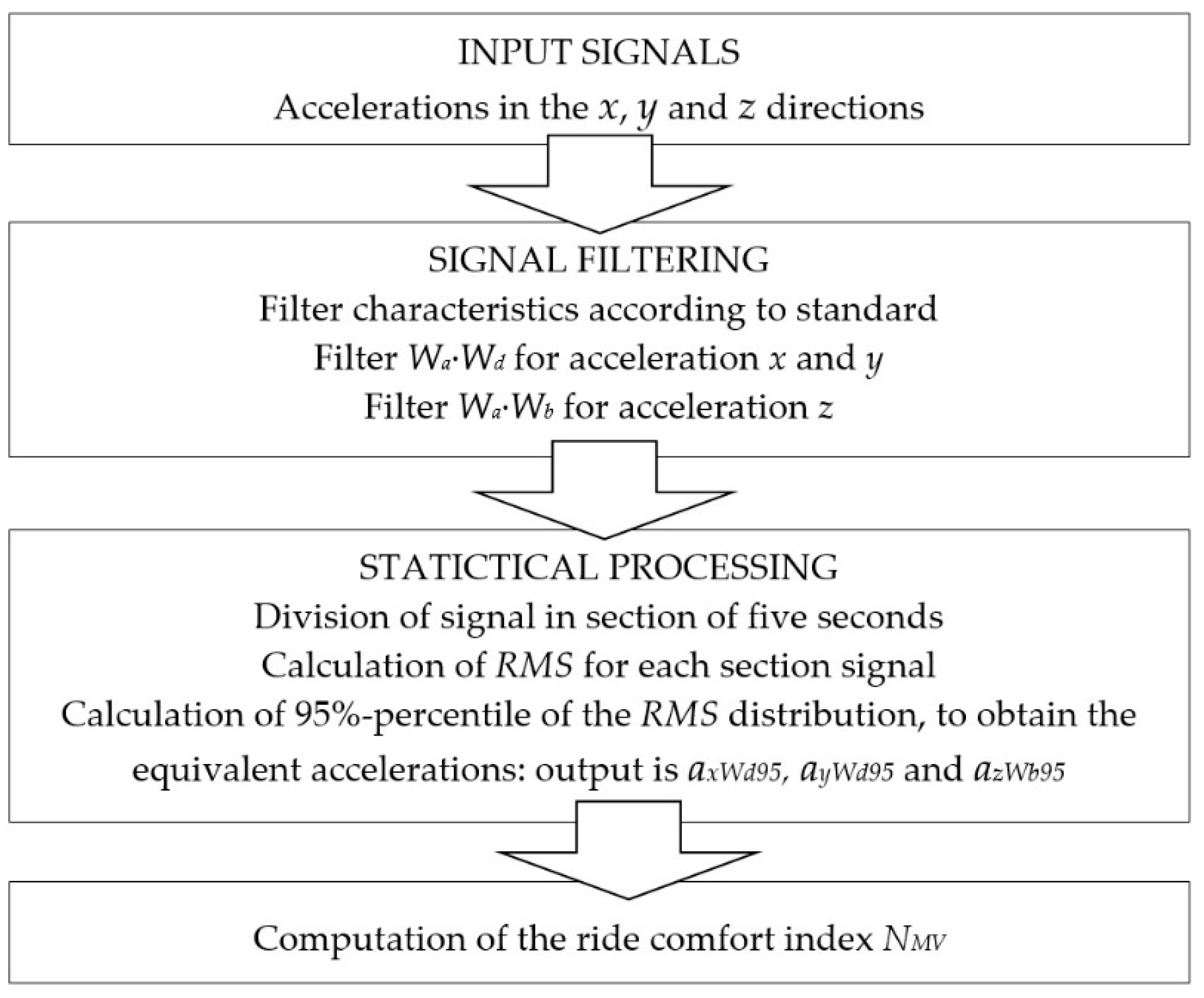


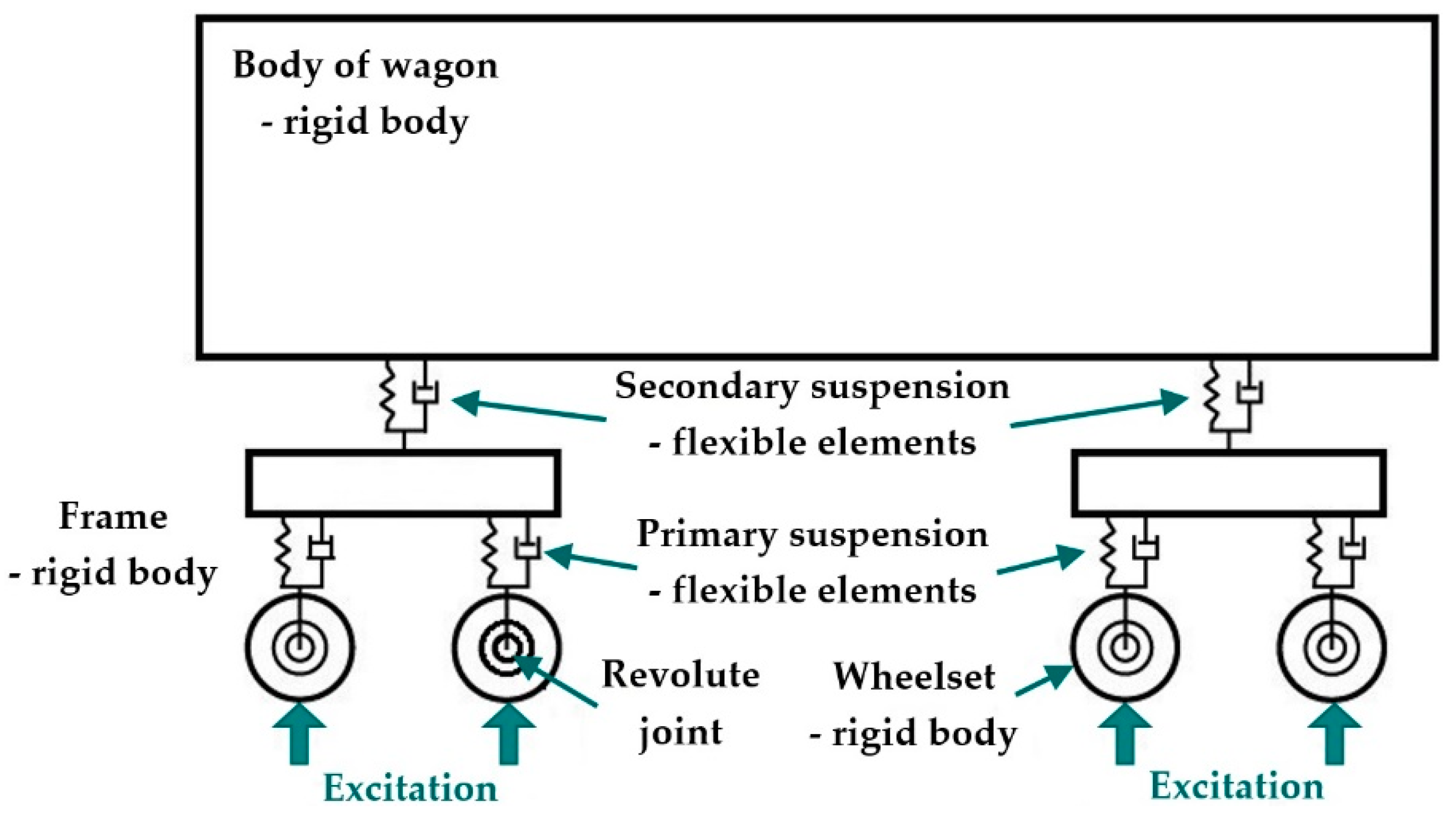
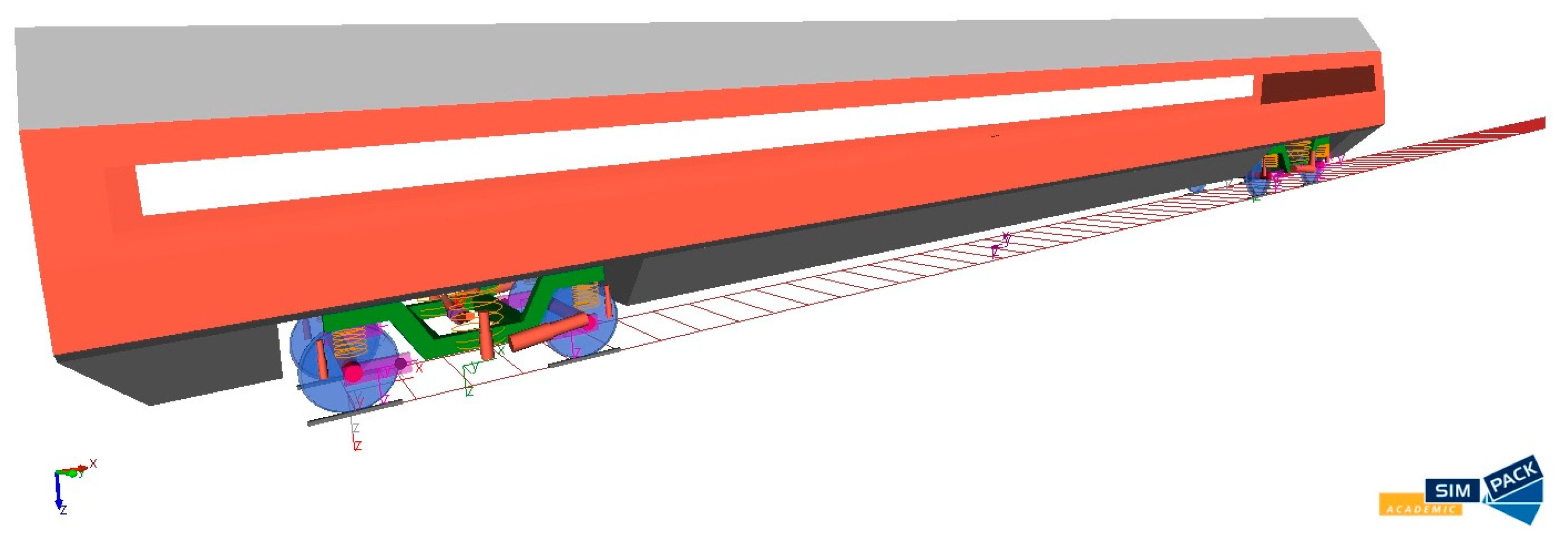
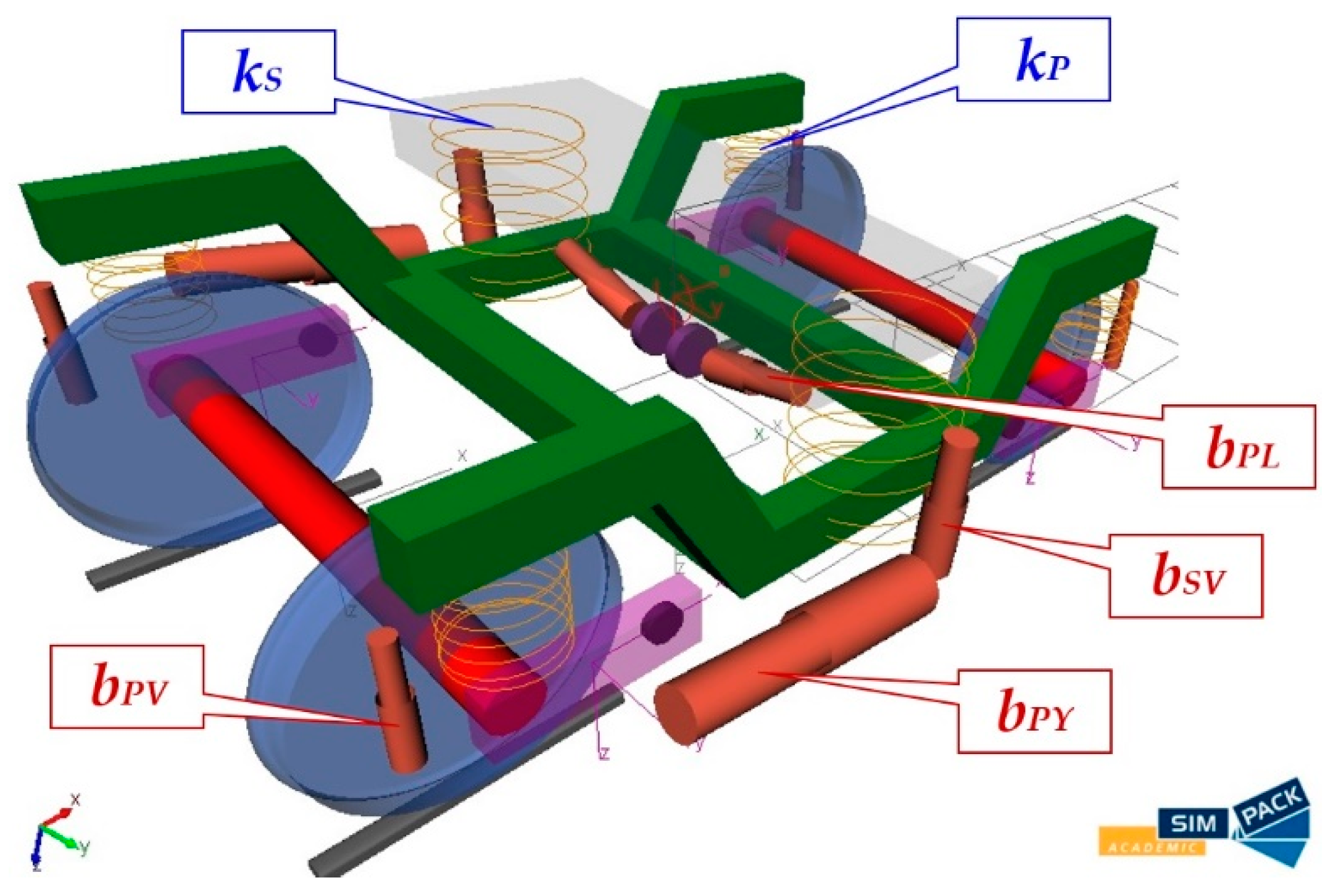
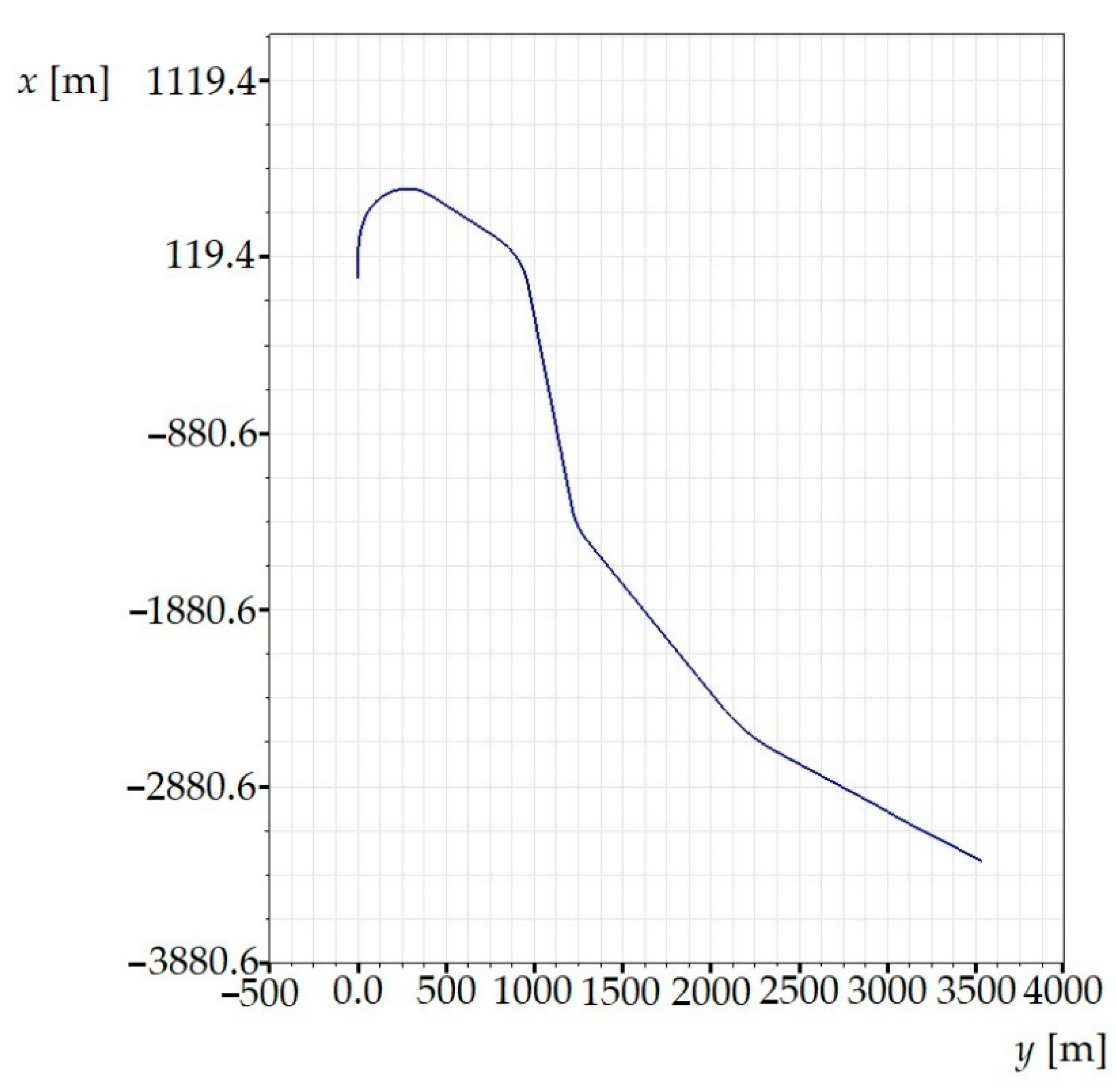
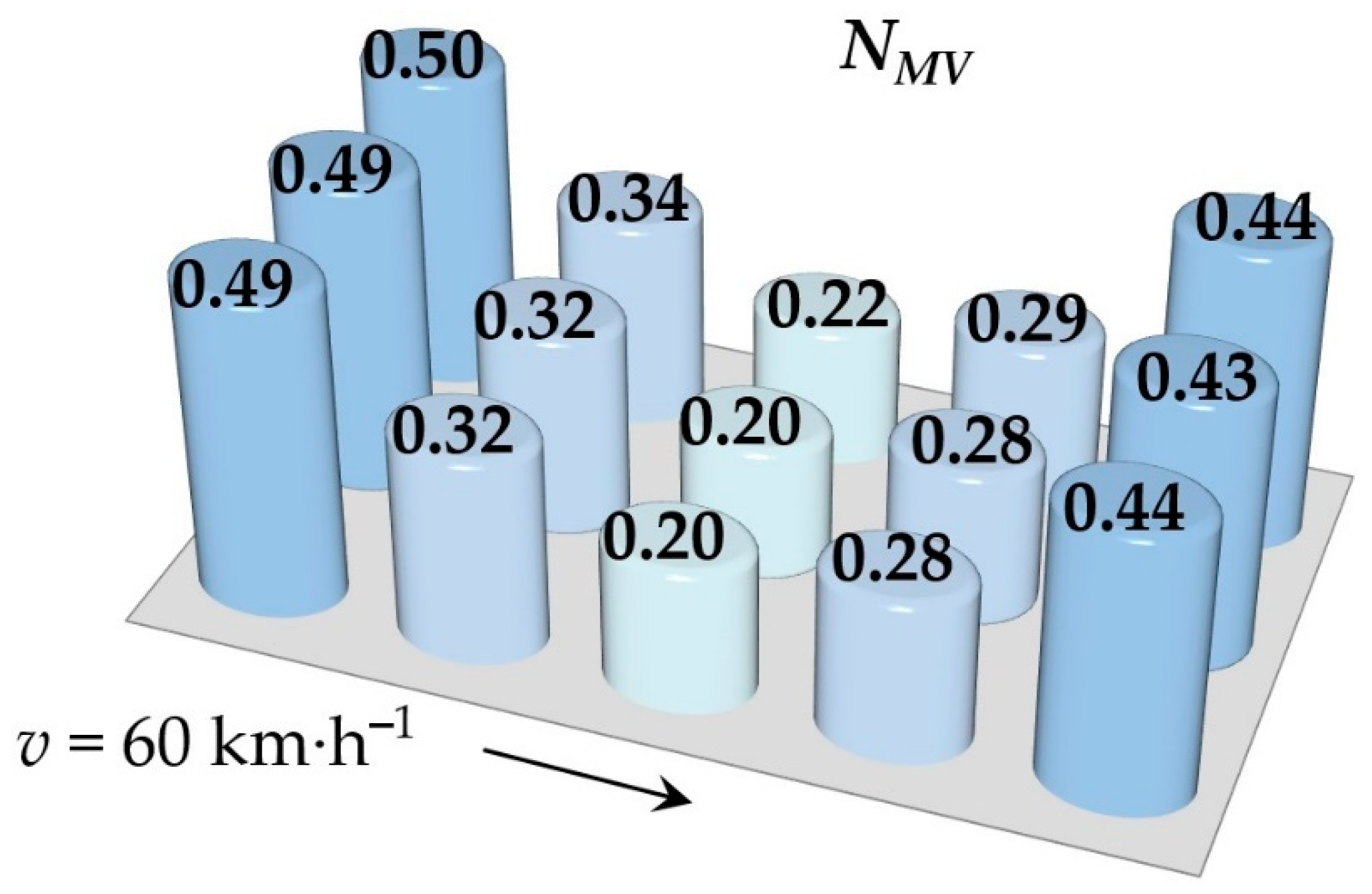
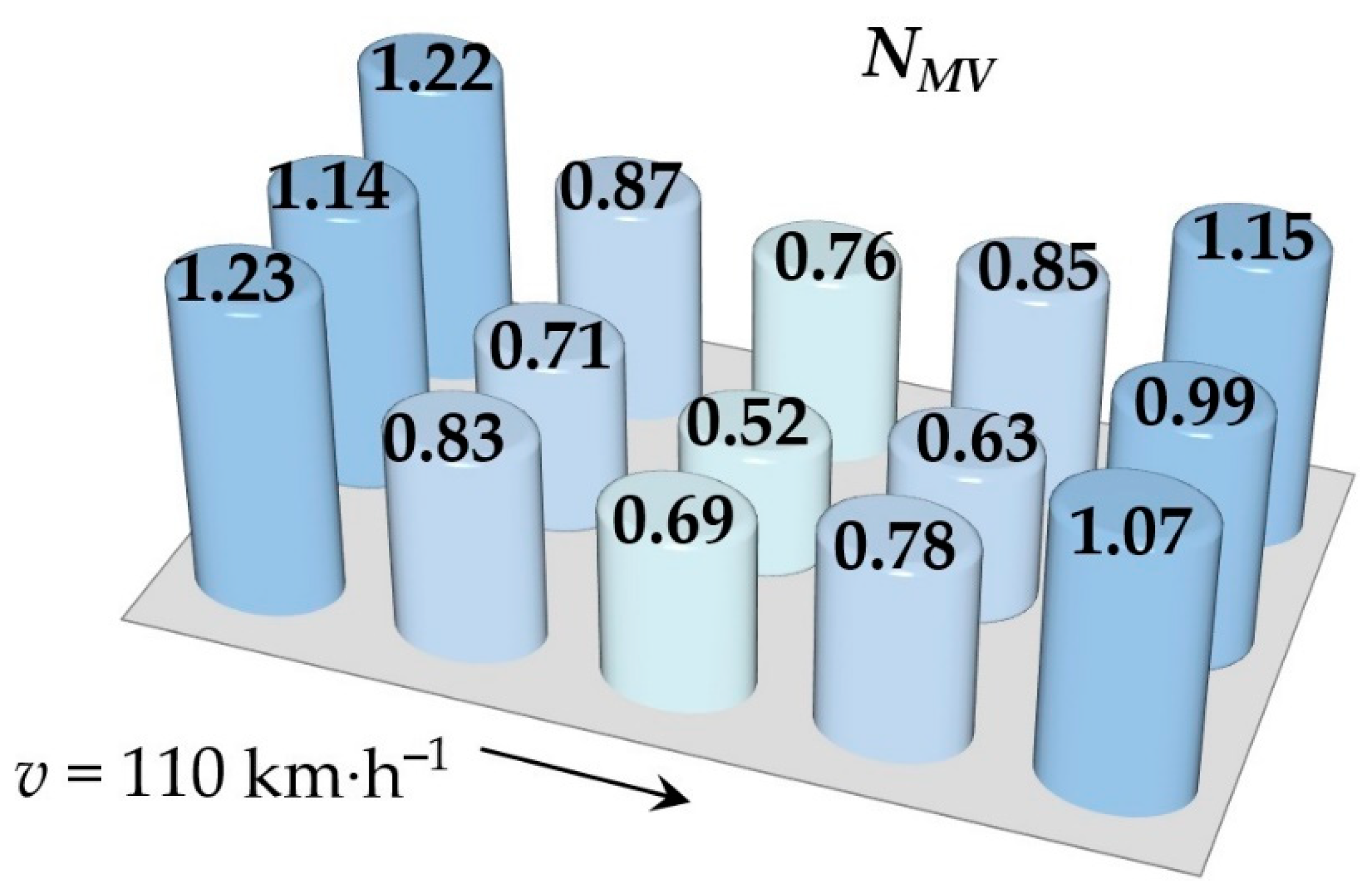



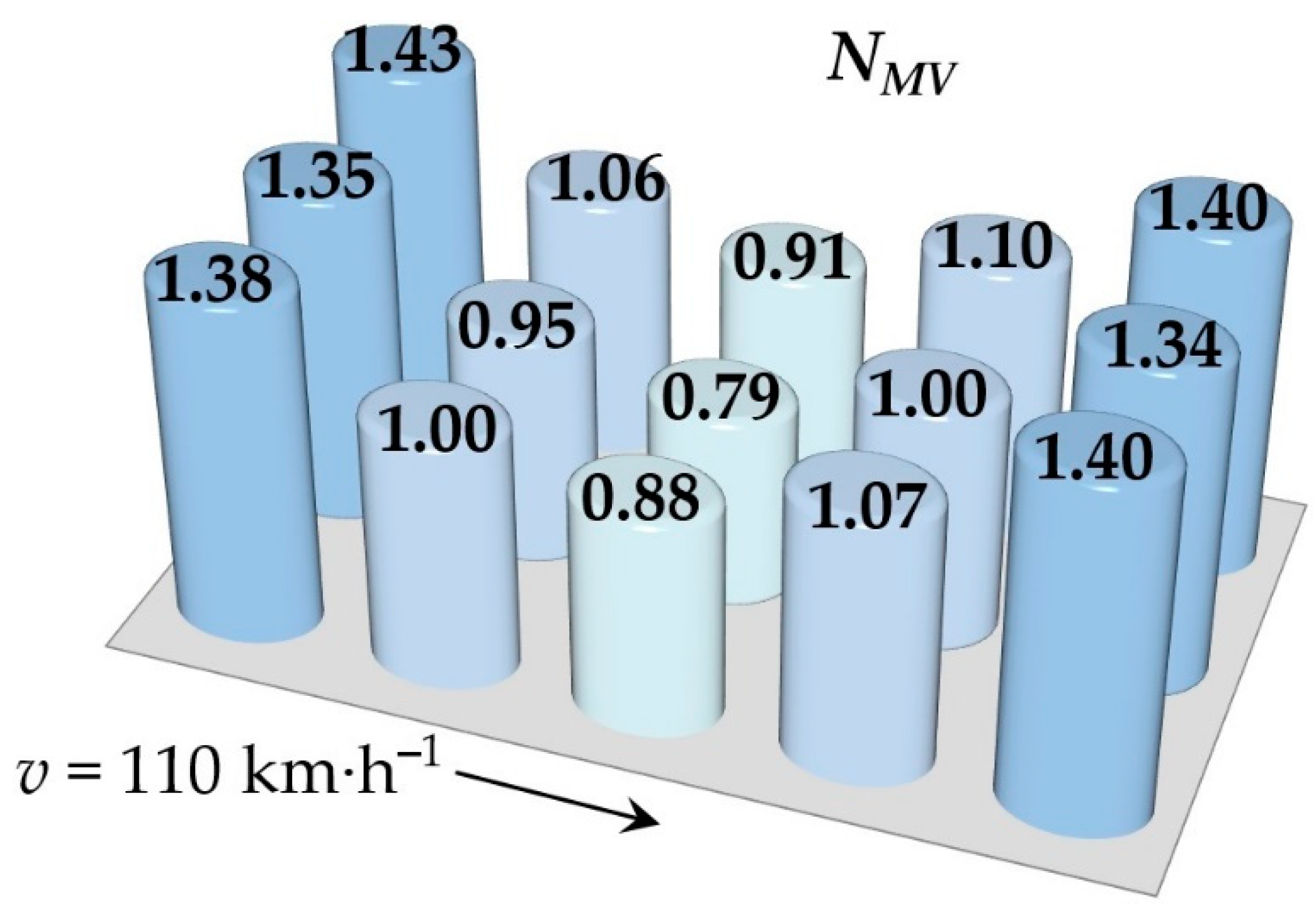
| Average Comfort, the Standard Method | ||
|---|---|---|
| Ride Comfort Index | Measured Quantity | Measured Location |
| NMV | Accelerations in three directions (x, y, z) | Floor |
| Value of the NMV Index | Level of the Ride Comfort |
|---|---|
| NMV < 1.5 | Very comfortable |
| 1.5 ≤ NMV < 2.5 | Comfortable |
| 2.5 ≤ NMV < 3.5 | Medium comfortable |
| 3.5 ≤ NMV < 4.5 | Uncomfortable |
| NMV ≥ 4.5 | Very uncomfortable |
| Stiffness | Damping | ||||
|---|---|---|---|---|---|
| Designation | Name | kP | kS | bPV | bSV |
| O | Original | 0% | 0% | 0% | 0% |
| I | Modification I | −45% | +45% | −45% | +45% |
| II | Modification II | +45% | −45% | +45% | −45% |
Publisher’s Note: MDPI stays neutral with regard to jurisdictional claims in published maps and institutional affiliations. |
© 2021 by the authors. Licensee MDPI, Basel, Switzerland. This article is an open access article distributed under the terms and conditions of the Creative Commons Attribution (CC BY) license (https://creativecommons.org/licenses/by/4.0/).
Share and Cite
Dižo, J.; Blatnický, M.; Gerlici, J.; Leitner, B.; Melnik, R.; Semenov, S.; Mikhailov, E.; Kostrzewski, M. Evaluation of Ride Comfort in a Railway Passenger Car Depending on a Change of Suspension Parameters. Sensors 2021, 21, 8138. https://doi.org/10.3390/s21238138
Dižo J, Blatnický M, Gerlici J, Leitner B, Melnik R, Semenov S, Mikhailov E, Kostrzewski M. Evaluation of Ride Comfort in a Railway Passenger Car Depending on a Change of Suspension Parameters. Sensors. 2021; 21(23):8138. https://doi.org/10.3390/s21238138
Chicago/Turabian StyleDižo, Ján, Miroslav Blatnický, Juraj Gerlici, Bohuš Leitner, Rafał Melnik, Stanislav Semenov, Evgeny Mikhailov, and Mariusz Kostrzewski. 2021. "Evaluation of Ride Comfort in a Railway Passenger Car Depending on a Change of Suspension Parameters" Sensors 21, no. 23: 8138. https://doi.org/10.3390/s21238138
APA StyleDižo, J., Blatnický, M., Gerlici, J., Leitner, B., Melnik, R., Semenov, S., Mikhailov, E., & Kostrzewski, M. (2021). Evaluation of Ride Comfort in a Railway Passenger Car Depending on a Change of Suspension Parameters. Sensors, 21(23), 8138. https://doi.org/10.3390/s21238138








